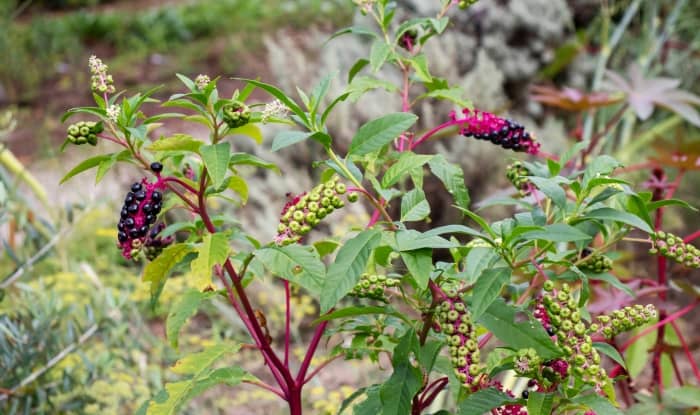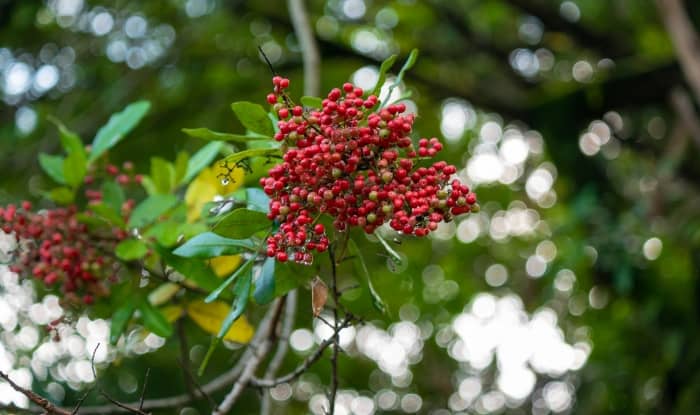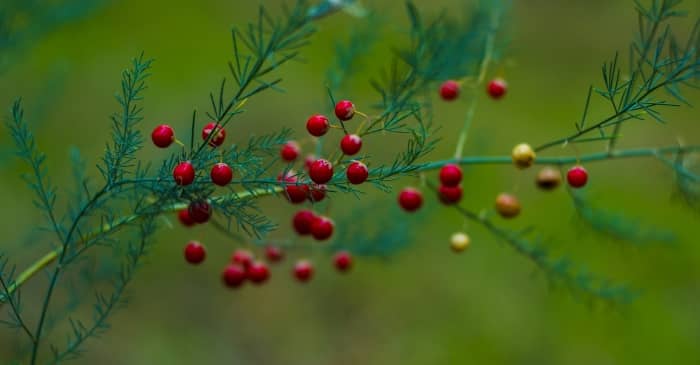Have you found weeds with red berries in your garden?
To help you identify them, we’ve compiled this list of the most common weeds with red berries. We’ll use photos and descriptions for easy recognition.
Let’s dive in.
Christmas Berry (Coral ardisia)

Christmas berry is also known as coral berry. It’s an upright small shrub often sold as an ornamental. But having escaped cultivation, Christmas berry has spread into woodlands where it grows in clumps between 3-6 feet tall and shades out native plants, preventing their development from seedlings and disrupting the local ecosystem.
The weed is well-known for its tiny bright red berries that hang in clusters. The large, thick leaves are dark green and glossy with scalloped edges and grow up to 8-inches long. The flowers are small, white, and sometimes pinkish.
Christmas berry is a prolific seed producer with a high germination rate. Seedlings often surround mature plants, eventually developing to form large Coral ardisia colonies.
American Pokeweed (Phytolacca Americana)
American pokeweed is also called dragonberries, inkberry, and poke sallet. Pokeweed is a large perennial broadleaf weed. This invasive weed variety causes problems when it rapidly spreads into a new area, displacing native plants that struggle to develop in the shade of pokeweed’s bushy growth.
Pokeweed has very distinctive fruit. The weed produces large clusters of dark purple-red berries at the end of bright red stems. The red stems of the weed are also smooth, hairless, and partially hollow.
You’ll often see immature green berries and shiny ripe red berries in the same cluster. The berries are poisonous, so although they look juicy and appetizing make sure to leave them alone.
It’s easy to identify pokeweed by its fruit, but also look out for large, bright-green leaves that grow alternately. And before the berries develop, the plant produces clusters of small white flowers.
To identify weeds with purple berries, check out our guide.
Wild Strawberry (Fragaria virginiana)
Wild strawberry is a herbaceous perennial that grows low to the ground and produces easily recognizable red berries when it fruits between June and July. Because the fruit can be delicious, some people don’t mind having wild strawberries growing in their yard, but others consider it an annoying weed.
Wild strawberries thrive in moist soil and sometimes cause problems for gardeners in lawns with drainage issues. Once they become established, they can be hard to control as the weeds spread by runners and seeds and return each year after the winter.
Wild strawberry blooms from April to May, producing clusters of white flowers with five petals. The leaves of the plant consist of three egg-shaped leaflets with toothed lobes. The stems of the weed are hairy.
Bittersweet Nightshade (Solanum dulcamara)
The bittersweet nightshade plant is also known as blue bindweed, bitter nightshade, poison berry, and climbing nightshade. Bittersweet nightshade is a perennial woody vine that grows up to 10 ft. in length and climbs when there’s adequate support.
All plant parts are toxic, and the noxious weed produces clusters of poisonous bright red berries in the fall. Ovate leaves grow alternately on the stiff stems. The leaves are dark green and sometimes purple-tinged and reach between 2-4 inches long. From May to September, the plant produces small bright purple flowers with eye-catching yellow anthers that hang in clusters.
Bittersweet nightshade spreads by seeds and can grow from stem and root fragments. You’ll often find this weed growing around field edges, gardens, parks, roadsides, and wetlands as the plant likes moist soil.
Bittersweet nightshade is toxic. Although not the same plant or as dangerous as deadly nightshade — a weed you can identify by its black berries — it can cause sickness in animals and children that eat its berries, sometimes fatal.
Italian Arum (Arum Italicum)
Italian arum is a herbaceous perennial. Originally an ornamental plant, Italian arum is now considered an invasive weed in some US states because of its rapid spread and difficulty to control.
The weed grows well in most soil types but prefers moist soil. And it thrives in partial shade to full sun.
In the summertime, the weed has distinctive orange-red berries that grow on an erect central fleshy stem. The berries are poisonous to humans and animals.
The leaves are glossy and grayish-green with white veins and long petioles. The leaves are shaped like an arrowhead and die back after the plant blooms before new leaves emerge in the fall. Between April and May, Italian arum produces creamy white flowers.
All parts of the Italian arum plant are toxic, and touching the weed can cause skin irritation.
Autumn Olive (Elaeagnus umbellata)
Autumn olive is also called Japanese silverberry and spreading oleaster. The plant was originally introduced to North America from Asia in the 19th century. Autumn olive was planted widely for wildlife food and soil erosion prevention before recognition of its invasive nature. Autumn olive is a prolific producer of small lightly-speckled red berries that are widely distributed by mammals and birds, helping the weed spread rapidly.
Because Autumn olive can fix nitrogen in the soil, it can affect native plant communities that grow in low nitrogen soils in prairies and barrens. The increase in soil nitrogen encourages weed species to spread into the area displacing native plant species.
Autumn olive is a deciduous shrub or small tree. It grows up to 20 ft. tall and 30 ft. wide and shades out plants in the areas it invades with its bushy growth. The leaves are oval-shaped with wavy margins and a pointed tip, and grow alternately up to 4-inches long. The top surface of the leaves is bright green, with a silvery-scaly underside.
The plant blooms from April to June, producing tubular light yellow or cream flowers with a strong fragrance that grow in spikes at the end of stems.
Brazilian Pepper Tree (Schinus terebinthifolia)
The Brazilian pepper tree is a native of Brazil, Paraguay, and Argentina. Introduced to Florida in the mid 19th century as an ornamental, the Brazilian pepper tree has since escaped and spread and you can find it in the United States in California, Texas, Georgia, Alabama, and Hawaii.
The Brazilian pepper tree is an invasive weed that spreads aggressively, quickly infesting disturbed sites and displacing native plants in a wide range of habitats, including grassland, coastal wetlands, forests, farmed land, mangroves, and pineland.
The Brazilian pepper tree is an evergreen shrub that can grow over 30 ft. tall. The woody weed has smooth gray bark and alternate pinnate leaves with shiny green elliptic leaflets that are finely toothed and almost hairless. The bright red berries grow in dense clusters and are usually mature by December. When squashed, the berries have a brown pulp that’s aromatic and resinous. The plant produces clusters of white flowers 2-3 inches long from September to November.
The Brazilian pepper tree is in the same family as poison ivy, poison oak, and poison sumac, and can cause issues for people with sensitive skin.
Sacred Bamboo (Nandina domestica)
Sacred bamboo is also known as heavenly bamboo or nandina. This plant is an invasive weed that originated in East Asia and is often sold in garden centers and nurseries in the US as an ornamental.
Sacred bamboo is an evergreen shrub that grows between 6-10 ft. tall and 3-5 ft. wide. The plant has many shiny dark-green stems that resemble bamboo stalks. Growing alternately from the stems are large bi-pinnately compound leaves consisting of many small leaflets that are pointed and oval-shaped. Young leaves are sometimes pinkish before turning light green as the plant matures and often develop a red tinge in winter.
In the summer, clusters of tiny white flowers develop at the end of the stems. The flowers give way to shiny red berries, visible in the fall and winter. The berries are poisonous to people and wildlife.
Sacred bamboo is a shade-tolerant plant that you’ll often see growing in forests, where it forms dense groves and displaces native plants. But the weed also grows in full sun.
Asparagus Fern (Asparagus densiflorus)
Asparagus fern is also called broom asparagus, asparagus fern, and foxtail fern. Asparagus fern is often an ornamental garden plant or an indoor house plant, but it’s also an invasive weed in many areas. Asparagus fern forms large, dense infestations that smother native plants and prevent their seedlings from developing.
The plant produces oval-shaped leaves that grow from tough green stems with spines. Small pinkish-white or white flowers grow in clusters from the stems in spring. And in the summer, small berries appear. The berries are round and initially green, but as the weed matures, the berries turn red.
Asparagus fern spreads by seeds and rhizomes. It thrives in shady locations with well-drained soil. But the weed can also grow in full sun. You’ll often see Asparagus fern growing in disturbed areas and wasteland, around forest margins, and in the riparian zone along the edge of lakes, rivers, and streams.
English Holly (Ilex aquifolium)
English holly is also known as Christmas holly, and the name is often abbreviated to holly. Holly is an introduced plant in the United States where it’s grown as a landscape plant. But in many areas, holly is now an invasive weed that outcompetes native shrubs in the areas where it spreads, often in forests.
Holly is a large evergreen shrub or small tree. It’s a slow-growing plant that reaches from 15-50 ft. tall and 15 ft. or wider. Holly has woody stems and leaves that are oval-shaped and shiny. The leaves are dark green on the upper surface and light green underneath and grow alternately on petioles from the stems, reaching 2-5 inches long. The leaves are thick, and young leaves are spiky, with sharp spines on the sides that often smooth out as they get older.
Holly blooms in the spring, producing sweet-scented small, white flowers that change into orange, yellow, or red berries in the winter. The berries are poisonous to people and many animals, but not to birds that disperse the seeds and help the weed to spread.
Bloodberry (Rivina humilis)
Bloodberry is also known as pigeonberry, baby peppers, and rouge plant. The plant is native to Southern United States, Central America, and tropical South America and is an invasive weed in other locations.
Bloodberry is a low-growing perennial herb that usually reaches a height up to 1.5 ft. when fully mature (but sometimes taller) and often grows beneath shrubs and trees. The leaves are green with wavy edges and grow 1-3 inches long. The flowers are white to pink and develop in elongated clusters at the end of the stems. The weed produces many red berries that are almost translucent and that often grow on the lower stem while flowers are still blooming on the upper stem.
Bloodberry prefers to grow in damp shady places. You’ll often find the weed growing in and around forests, gardens, bushland, wasteland, and disturbed sites.
Sumac (Rhus)
A CLUSTER OF STAGHORN SUMAC BERRIES
Many species of sumac have deep red berries. Common examples include staghorn sumac and smooth sumac.
The sumac varieties with red berries are not to be mistaken with poison sumac, the toxic plant that produces clusters of white berries. It’s not safe to touch poison sumac because it can irritate your skin, and certainly not a good idea to eat its berries. But in contrast, you can eat the red berries of other sumac species.
STAGHORN SUMAC TREE
Sumacs are usually small trees or shrubs. They often have compound pinnate leaves, with many leaflets growing from a central stem. But you can get sumac species with trifoliate leaves or simple leaves.
There are about 250 species of sumacs. Some of them are weeds that produce red flowers. Others produce greenish or cream flowers.
STAGHORN SUMAC WEED WITH RED BERRIES IN THE WINTER
Sumac plants often spread by suckering, pushing up new shoots from the root system and forming small thickets, crowding out and suppressing native vegetation. Some sumac species can be highly invasive.
Cotoneaster (Cotoneaster glaucophyllus)
COTONEASTER BERRIES BY JOHN TANN
Cotoneaster is an evergreen shrub, originally imported from China as an ornamental, but the plant has since escaped gardens to become an invasive weed.
The weed produces clusters of orange-red or scarlet berries that range from 4-7 mm in diameter. Birds feed on the fruit and disperse the seeds over a wide area helping the weed spread. But the berries are mildly poisonous to people, livestock, and pets. The weed can also spread through branches and stems that reroot when they touch the ground.
The leaves are pale blue-green and dull on the upper side, hairless or sparsely covered. The underside of the leaves is often hairy but loses the hairs as the plant ages. The stems are erect and covered in soft hairs in young plants, but as the plant matures, they turn hairless and change color to dark-reddish purple. The flowers grow in clusters and can be white in some species, pink to rose in others.
The weed sometimes grows in dense thickets that shade out native plants in the areas it infests. Cotoneaster usually grows to under 10 ft. tall, but sometimes it grows taller.
The plant can thrive in a variety of conditions, being tolerant of the heat and the cold, drought and damp conditions, salt, and a range of soil types.
You’ll often find cotoneaster growing in coastal areas, inshore islands, riverbeds, forest margins, shrublands, and disturbed places near residential areas.




























Im looking for weeds that cause problems in a greenhouse
environment. Are there any?
Hi Katherine, there are weeds that are common in greenhouses. You can find a good list here:
https://www2.ipm.ucanr.edu/agriculture/floriculture-and-ornamental-nurseries/Greenhouse-grown-Crops-Inside-Greenhouses/
What will kill burr weed that is in a predominately St. Augustine lawn?
Hi Tim, weedkiller containing atrazine as the main active ingredient is safe to use on St. Augustine grass.